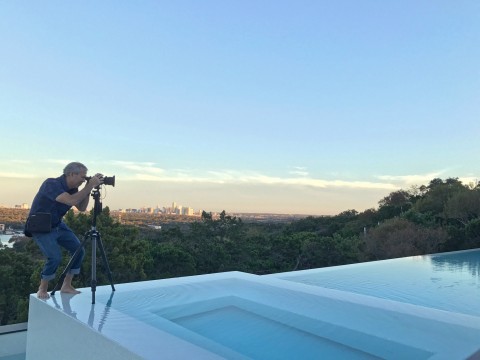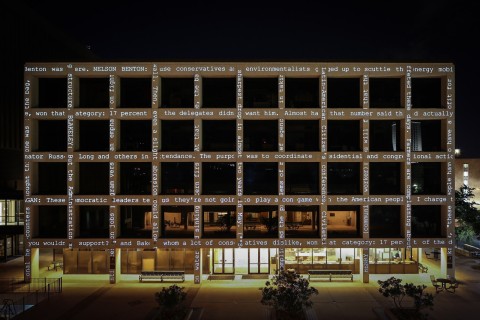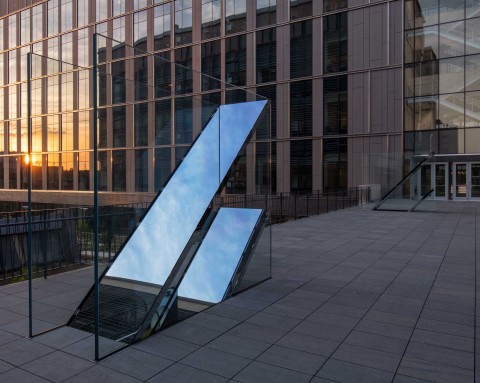
Looking Back with Photographer Paul Bardagjy
In celebration of Landmarks’ 15th anniversary, we developed a blog series profiling several people that have made our program a success. This entry in our “Looking Back” series features photographer Paul Bardagjy, whose images have helped define how people view, interpret, and access our collection.
A celebrated photographer of both art and architecture, Bardagjy began his work with Landmarks in 2008. He documented the foundation of our collection–28 sculptures on long-term loan from the Metropolitan Museum of Art. Bardagjy began by immersing himself in the collection and considering the various ways he could interpret it through the lens of his camera.
“My initial introduction to Landmarks was just by going around and documenting the collection on my own,” said Bardagjy. “My assistant and model Natalie and I just went off and documented everything. It was fun because I could set the schedule and look for the best light and just work my way around the collection. Typically, I would probably be in a little bit more of a hurry to get through the job, but that was a really nice way to do it. I could take my time and just go around leisurely and really cover everything properly.”
With this initial set of images, Bardagjy establish a dynamic visual foundation for how the collection would be viewed for years to come. Since then, he has documented each new project that Landmarks has commissioned or acquired. Bardagjy does more than simply photograph the works; he uses his lens to capture the sense and experience that one has when engaging with art.
“The camera sees things slightly different than our eyes see things” said Bardagjy. “My job is to try to use that tool to replicate the experience that we have when we go into a space or look at an object.”

The notable discrepancy between what the eye sees and what the camera is able to capture is experienced by visitors who take photos in James Turrell’s Skyspace, The Color Inside. Each sunrise and sunset, a pre-programmed light sequence fills the Skyspace with brilliant washes of color. Through Turrell’s masterful manipulation of light, the sequence causes the sky, which is viewable through an opening in the ceiling, to appear in unimaginable hues. Our mind unexpectedly generates unreal or hyperreal colors, making it difficult to get shots that approximate the eye’s vision.
“Watching the sequence, it seems like the sky is changing colors because your eyes are so affected by the projected color on the interior walls. It appears that the sky is changing color and we wanted to try to show that to a degree in the documentation” said Bardagjy. “It was a challenge in terms of just being able to do it, but also to know what to do. In the end, I think we got some pretty iconic images of it.”

The Skyspace isn’t the only work in Landmarks’ collection that has proved difficult to capture. Ben Rubin’s digital installation, And That’s The Way It Is, features excerpts from archival and contemporary new feeds that weave together and project every evening on the gridded facade of the communications building in the Walter Cronkite Plaza.
“We made a couple of trips out there, but the key is that you want to have enough ambient lighting so that there's some detail on the building,” said Bardagjy. “But you know, when the art is done, there really isn't anything that I can't get on an image that we see. So, if you and I can see something with our eyes, then there's no reason why it can't be photographed that way. It's just a matter of knowing the right timing and in a lot of cases knowing how to get the lighting correct.”
One of Bardagjy’s most recent jobs for Landmarks was documenting Sarah Oppenheimer’s C-010106. The task proved complex due to the work’s reflective glass panels and scale.

“I think the most difficult thing about that installation is really the fact that it's so subtle,” said Bardagjy, “It's difficult to frame it in such a way that you can get a sense of the entirety of the project.”
The two apparatuses that comprise Oppenheimer’s C-010106 are oriented on the surface of a pedestrian footbridge that connects two buildings at the Cockrell School of Engineering. The artist paid considerable attention to viewers’ experience viewing the work both on the bridge and below it, creating unexpected sightlines and social encounters. These spatial and experiential considerations aren’t easily captured in photographs.
“The trickiest thing about framing the work was that those two pieces are pretty far apart from each other,” said Bardagjy, “and getting them to speak to each other in the photographic frame was complicated.”
Bardagiy has created an incredible repository of images for Landmarks, capturing the beauty, nuance, and spirit of each work in the collection. Reflecting on the past 15 years, he remarked:
“The time that I've had working with Landmarks has been a highlight of my career. I mean, it's like having this incredible resource right in my own backyard, right around the corner. I just feel that it's an incredible resource for Austin, so hats off to everybody at Landmarks!”
---
Photo of Paul Bardagjy by Ashley St. Clair
